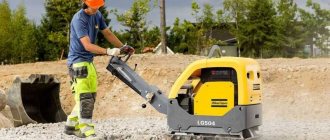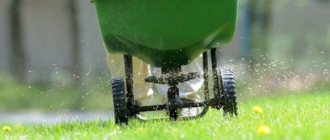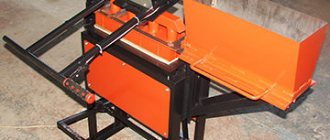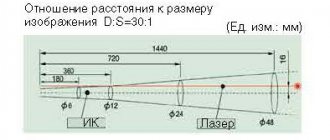The industry produces equipment for the production of paving slabs with different technical and operational characteristics from different structural materials. Some construction machines/mechanisms are used in all technologies without exception, for example, a gravity concrete mixer. Other equipment is highly specialized for a specific type of raw material.
How are paving slabs made?
The technology for making paving slabs is quite simple: a sand-cement mixture is poured into molds and hardens. But tiles made in this way will turn out loose and very fragile.
To obtain the desired product, a vibropress is used, in which concrete is poured into a vibrating matrix, and a press presses on top of the cement mortar. The industry produces similar machines.
They are designed for the production of tiles on an industrial scale. Factory vibrating presses are very expensive; if you are not going to use the machine for commercial purposes, then purchasing it does not make sense.
You can make this mechanism yourself.
Types of FEM and production technologies
The category of figured paving elements FEM includes three large groups - cobblestones, paving stones and paving slabs. Cobblestones are natural pellet stones collected in river beds. Paving stones are also a natural stone, but subjected to mechanical processing. It is either trimmed or sawed to give the same size and shape.
The last group of the FEM category, paving slabs, is always made from several raw material components. This facing material is used extremely rarely for paving roads due to its high labor intensity, low strength and service life. But paving slabs are laid on pedestrian paths, in squares, in parking lots, cottages, and gardens. It beautifies the paths of private houses, the blind areas of buildings, and even the steps of external stairs and the terraces of country cottages.
The classic version of FEM is paving slabs made of cement concrete. In manufacturing, the technology of vibrocasting, vibrocompression or hyperpressing is used. This will require different equipment and its quantity. The characteristics of paving slabs will differ:
| Properties | Vibrocast | Vibropressed | Hyper-pressed |
| Resource, years | 20 | 15 | 20 |
| Frost resistance, cycles | 100 | 200 | 200 |
| Abrasion, g/cm² | 0,8 | 0,5 | 0,3 |
| Water absorption,% | 7 | 6 | 2 |
| Strength class | B22.5 | B30 | B30 |
| Compressive strength, kgf/cm² | 300 – 400 | 300 | 780 |
| Roughness of the front surface | smooth | rough | polished, ground, rough |
| Form | any | rectangular | rectangular |
To reduce water absorption and increase frost resistance, instead of cement in concrete, polymer resins can act as binders. The filler, as before, remains sand or screenings of granite, diabase, and marble. Polymer concrete paving slabs are stronger than the two previous options and practically do not absorb moisture.
The simplest machine for the production of paving slabs using the vibration casting method is a table with a vibration motor on spring supports. When vibropressing, a press with a force of 10–16 MPa with a vibration motor is used. For hyperpressing, a more powerful single- or double-acting press is used.
When choosing crumb rubber as a raw material, the extrusion method is used. A ribbon is formed from the heated mass and fed into the press chamber. The material is 100% waterproof, not exposed to ultraviolet radiation, and is not afraid of temperature changes.
Components for brick making press
To create a brick making machine, you need to imagine how it works (you can see the operation of a factory machine), the principle is the same.
Main components of the machine:
- Plate;
- Tabletop;
- Press;
- Vibromechanism.
Before starting production, it is important to make drawings of the parts. You can find several options for the machine on the Internet. You should choose based on the availability of components.
There are options for simpler brick presses, and there are more complex and powerful ones. To calculate the size of the machine, you need to decide on the size of the tile and the number of matrices. There is no point in creating a device for one form.
Equipment for printing on ceramic tiles
UV printers are used to apply designs to ceramic tiles. Printing on such a surface requires refilling with special inks with high adhesive properties and glaze paints. After completing the graphic image, polymerization is performed with a UV lamp. Printers for applying patterns to ceramics are inkjet and laser.
When producing small batches, inkjet ceramic printers are used. They are mainly used to create black and white images. For large volumes of products, a laser printer will be required. First, the picture is made on decal paper, and then it is transferred to a tile and fired in a kiln. Before painting, the tiles must be degreased.
Commercialization of ceramic tile production
Unlike large industries, small businesses in this area have some great advantages. The main thing is the wide range of manufactured products, which is unlikely to be offered by a large manufacturer. An important advantage of small-scale tile production is the ability to produce high-quality products at a low cost. At the same time, the technology for manufacturing ceramic tiles can be mastered quite quickly.
Favorable for entrepreneurs specializing in the production of ceramic products was the depreciation of the currency, which entailed an increase in the cost of foreign products. The minimum number of fixtures for producing ceramic tiles will cost you $10,000. This includes a mixing device, a vibrating machine, oven drying equipment, a painting and glazing chamber, and special molding equipment.
To produce specific tiles, you will need additional equipment and devices. Also, don’t forget about stencils for applying designs, which cost about $600.
Toilet paper is a necessary element of our everyday life. What equipment is used to produce toilet paper?
Here you will learn everything about the instruments and equipment used in dentistry.
Detailed information about the production process of disposable tableware is on the page.
The main competitive advantage is the quality of the product, which depends primarily on the source materials for preparing the charge mixture. Therefore, high-quality granite screenings and plasticizers will be needed. For example, to produce tiles covering an area of 5,000 square meters, the cost of raw materials will be about $12,000. To organize the production of such a number of tile products, four workers will be required.
It is necessary to involve a specialist in the work to control and adjust the production technology. A warehouse with an area of 100 square meters is suitable as a premises.
As a result, summing up all the costs, we get:
— one-time costs of $30,000;
— monthly production costs are about $18,000.
The average price for selling one square meter of tiles is $7. With a volume of 5,000 square meters, the monthly income will be $35,000.
Models of modern equipment
Currently, the construction equipment market offers many different types of devices for the production of ceramic tiles. Canon brand printers for color printing on ceramic tiles create images using a CMYK topographic scheme. Low cost, high quality and speed of work set them apart from most analogues.
Among vibration stands, Saratov equipment “Mars” is popular. They have relatively small dimensions and high performance, while their price is significantly less than their foreign analogues.
A wide selection of concrete mixers is offered by the Zlatoust Concrete Mixing Equipment Plant. For organizing small or medium-sized production, mini RBUs with a capacity of 10 to 50 cubic meters per hour are suitable. Their only drawback is the lack of automatic operation.
Making a table
The machine table is a metal frame with welded legs. Dimensions are selected in accordance with the expected power of the structure.
Approximate dimensions:
- 50 by 70 centimeters or 70 by 100 centimeters.
- The height of the legs of the mechanism must correspond to the height of the person who will work on it.
- To make the legs, you can use a steel angle 10 centimeters wide, a ten-centimeter pipe or a tenth channel.
- The load on the legs will be large, so they need to be reinforced with gussets (steel rectangles welded to the leg and frame).
If the machine does not change its location, it is recommended to fill the legs with concrete.
Making a tile vibrator with your own hands
The structure consists of a metal or plywood plate (multilayer plywood with a thickness of at least 10 mm is used), a vibrator with an eccentric and a drive motor. An electric motor is usually used.
Important! It is not advisable to install an eccentric on the electric motor shaft, since the bearings will quickly fail.
Such a mechanical vibrating plate can be used not only for surface preparation and direct compaction of laid paving slabs. With its help you can prepare any flat area.
But the most significant savings are the production (and not the purchase) of paving slabs or paving stones. In this case, it is not necessary to purchase industrial equipment; you can make a brick press with your own hands.
Frame making
Prepared blanks for the frame are welded using electric welding. Weld seams are cleaned using an angle grinder, then the entire workpiece is painted. It is advisable to paint in order to prevent rust: the cement-sand mixture is diluted with water.
The frame must have no in-plane displacements.
Vibration pressing
The technique involves the use of a semi-dry working solution and almost complete automation of the production process. To work, you will need concrete mixers that allow you to prepare a working solution with a low liquid content, and a brick press.
A brick press is an automated device whose operating principle is:
- The semi-dry working mixture is supplied to the matrix molds from the loading hopper. The forms are placed on a vibrating table;
- the punch is lowered, pressing the solution against the matrix;
- vibration is turned on (vibrating table and punch);
- vibration is turned off, the matrix is removed from the product;
- The module is moved from the brickmaking press along a conveyor belt, and the cycle is duplicated.
A guillotine is a special device for splitting/cutting paving slabs. In practice, an ordinary grinder with diamond wheels is used instead.
To fully automate the process, a guillotine and loaders may be required. In addition, different types of equipment are used for work - a brick press can be stationary or manual.
A manual unit is optimal for producing material in small volumes . The device does not use a hydraulic drive, and pressing is carried out using an inertial load. The machine is installed on a flat surface and plugged into an outlet.
Characteristics of the resulting material:
- long-term operation;
- the modules are characterized by strict geometry and a rough surface;
- The concrete used in the batch has a low cement to water ratio. This determines the frost resistance (200-300 cycles), strength (M200/M400) of the tiles and reduces cement consumption.
The technique allows us to produce large volumes of modules, but of a limited variety. The quality of the tiles is higher than that of cast analogues , however, to obtain a fundamentally new product, you will need to purchase a new block with a matrix and reconfigure the equipment. For vibration casting, it is enough to buy a new mold.
Making a countertop
This element of the press must be made with great strength because it will experience heavy loads.
- The dimensions of the table must match the tabletop.
- The frame is made from channel No. 10 or a corner 7cm by 7cm.
- The blanks are cut, trimmed and welded.
- When welding parts, it is necessary to ensure their evenness - during the welding process, metal structures can bend.
Then a rectangle is cut out of a 10 mm thick steel sheet, then placed on the prepared frame and welded. The top of the tabletop is a sheet.
Vibration casting machine
This machine is a flat metal table, firmly mounted on a metal spring suspension. Vibration is provided by an electric drive, the power of which should be directly proportional to the size of the table and, as a consequence, the number of simultaneously processed forms for the concrete mixture.
Vibrating table for vibratory casting
A small compact machine can easily fit into an ordinary garage, and in one working day it can produce about 1000 pieces of finished products, which is enough, on average, to cover a sidewalk with an area of 20 square meters.
It is not necessary to buy paving slabs; you can make it yourself. Manufacturing paving slabs is a technological process from start to finish.
Detailed instructions for laying paving slabs on sand are described here.
The recipe for making concrete paving slabs is described in detail in this topic.
Attaching the table top to the table
One way to secure a tabletop is to install it on springs. It is enough to install six springs about 12 cm long and 6 cm in diameter, which have great rigidity.
For springs, cups are cut out of the pipe. The diameters of the pipe and spring must match. The spring should sit tightly in the glass by one third of its length. The glasses are welded to the table and to the countertop, precisely marking their location points.
Business plan
The production of rubber tiles from crumbs is not very expensive. To create a small plant, you will need approximately 1,200,000 rubles.
To ensure the production process you need:
- an area of approximately 120-130 m2 for a workshop and warehouses for storing raw materials and finished products;
- 3-4 workers for one shift;
- accountant and manager.
1 m2 of tiles can be sold for 1,700 rubles, and 100 tiles can be sold wholesale for 62,000 rubles.
The profitability of such production is quite high - around 20-40%, and if up to 35 m2 of products are produced per day, then the costs incurred will pay off in 4-6 months.
During this time, you can receive sales revenue of about 7.5 million rubles. (35·1700·21 days·6 months = 7,497 thousand rubles).
Monthly:
- Income 35·1700·21 days. = 1,249.5 thousand rubles.
- Expense 920 thousand rubles.
- Profit 1249.5-920 = 329.5
Profitability will be:
329,51249,5∙100%= 26,4%
By gradually developing your business and increasing productivity, you can achieve a higher level.
Electric motor for brick making machine
For the operation of a homemade concrete block press, an electric motor is required. The engine should be selected more powerful. It is recommended to use VI99/E. You can use any electric motor by connecting it with a belt to an eccentric.
Depending on the type, the engine is mounted below on a table top or on a work table. The electric motor is secured with bolts. To prevent the nuts from loosening due to vibration, engraving washers are used.
Vibration press operation
To start the machine, just perform a series of simple steps. The technology for producing tiles using this method is simple:
- Lubricate the matrix with oil.
- Pour the concrete mixture inside the mold. Place the matrix on the tabletop, ensuring complete alignment with the punch.
- Use the lever to ensure compaction of the mixture by turning on the vibration mechanism for a while.
- Remove the product from the mold and send it to dry.
To determine the mixture composition required for paving slabs, its desired characteristics are taken into account. Traditionally, the components are cement with sand, crushed stone screenings, and pigment diluted with water. When you manage to make a brick making machine yourself, the production process itself is much simpler. It is only necessary to scrupulously follow the recipe composition of the ingredients used to prepare the mixture.
Press manufacturing
The quality of paving slabs depends not only on vibration, but also on the amount of compression. You won’t be able to construct a hydraulic press with your own hands (you can use a jack).
It is easier to use human physical strength to compress the solution. The part (punch) is not difficult to make.
It is enough to weld the bracket with the axle to the table (short side). A lever is made from the profile, with a bushing at one end and a handle at the other. The lever should not be too long. It is attached to the punch. On the handle there is a remote control for turning on/off the electric motor.
Plastic/polymer sand
In the mass production of plastic shaped paving elements, primary/secondary polymer is used instead of cement. The main difference is the temperature treatment of raw materials at the middle stage of paving slab production. The entire technological chain looks like:
- mixing agglomerate, pigment, sand of fraction 3 – 5 mm in a concrete mixer;
- melting the resulting mixture in an extruder;
- pressing of FEM elements in molds.
When heated, the plastic is evenly distributed between the sand particles, creating an extrusion of the same density without air bubbles and foreign impurities. Less press force is required when forming the finished product. The tile does not need to be steamed and dried; after cooling it becomes hard.
All operations are easily automated, so the equipment is produced in the form of production lines and mini-factories. Auxiliary equipment and concrete mixers for polymer-sand FEMs are similar to the previously discussed options from previous technologies.
Additionally, a melting and heating apparatus APN is used - an extruder, which is a two-stage granulator.
The production is waste-free, the raw material is often used plastic packaging. Therefore, in addition to the specified equipment, the following machines/mechanisms can be used:
- crusher of polymer recyclables;
- drum crusher for scrap FEM;
- sand drying machine;
- cooling equipment.
Molds are distinguished by removable punches, the presence of a cooling system, an ejector element, and a service life of 5,000,000 products.
How does a brick press work?
Before you start working on a homemade concrete block press, you need to properly prepare the cement-sand mixture.
The mixture consists of:
- Cement grade M 500;
- Crushed stone (fraction 5-10);
- Sand (fraction 2.5);
- Additives and dyes;
- Water.
To make high quality tiles, the mixture must be stiff. The tiles should have reduced moisture absorption and increased frost resistance.
You can check the prepared mixture using a truncated cone by lowering it into the solution. The mixture is considered to be of high quality if the steel cone enters the mixture 50 mm.
- Before filling with cement-sand mixture, the matrices must be lubricated with oil.
- This is done so that the cement does not adhere to the walls of the matrix.
- Then the cement mixture is distributed into molds.
- The matrix must coincide with the punch. By pressing the lever, the electric motor is briefly turned on.
- After this, the workpiece is removed from the matrix and laid out to dry.
With a strong desire, a minimum set of tools and materials, making a brick making machine yourself is a completely doable task.
Hyperpressing
To ensure the same strength of FEM throughout the thickness, a hyper-pressing technology has been created. It uses two presses, one presses on the punch from above, the second pushes the matrix from below. In this case, the vibrator becomes superfluous, so it is excluded from the design of the press.
Or a single-acting press with high compression force is used. This option is used only for FEMs of small thickness 4 – 6 cm.
To provide a wide range of paving stones - smooth, rough, textured, gray, colored, luminous, hyperpresses of various designs can be used:
- counter pressing two-sided symmetrical - rough front surface, high density of the product, coloring in the mass or only the top layer;
- double-sided asymmetrical counter pressing – “floating table”;
- symmetrical double-sided counter-pressing with vibration - smooth front surface, layer-by-layer painting, including luminescent and fluorescent compounds;
- one-sided pressing with a lower cylinder - high geometry accuracy, flash-free production, maximum possible productivity;
- one-sided pressing with filtration – production of paving slabs of complex configuration, large size, small thickness.
This business is, by default, highly profitable, since instead of sand, the concrete filler is screenings, amounting to 85% by weight. In many industries, screenings are waste, which helps reduce costs. In addition to cement, you need pigment for colored tiles or special paint for luminous paving elements.
Gravity concrete mixers are not suitable for automatic lines. Instead, forced-action concrete mixers are used.
In them, the drum remains motionless, and the blades rotate inside it. The quality of the mixture is higher than in gravity mixers, but the energy consumption is noticeably higher, which increases the cost of production.
For mini-factories, additional equipment of the following types becomes relevant:
- store feeders for pallets/pallets;
- vertical pallet stackers;
- transfer hydraulic grabbers;
- pallet unstackers;
- cement silo;
- automatic pallet packer.
At intermediate stages, equipment is used for removing flash, turning over FEM, packaging roller tables, power cabinets, hydraulic stations, conveyors, racks, synchronizers, and frequency converters.
Photo of a brick making press for paving slabs
Benefits of tiled flooring
- simple and uncomplicated production of road surfaces;
- inexpensive components for making tiles;
- convenient, low-cost installation;
- wide operating temperature range of application;
- not subject to bacteriological destruction from rot, mold and mildew;
- resistant to solar radiation;
- has excellent resistance to precipitation;
- meets environmental standards - does not evaporate, does not emit harmful substances, and is easily disposed of;
- does not interfere with gas and moisture exchange between the soil and the atmosphere;
- has high aesthetic properties - due to the various shapes and wide color palette of products.











